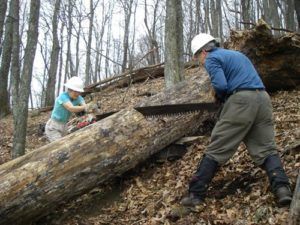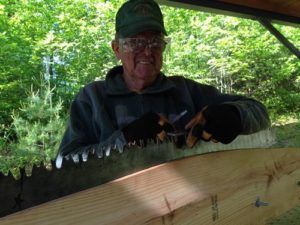by Gannon Coffey
Tips for Silent Sawyers
This article was originally published in the July 1986 issue of The REGISTER.
“Although the two-man, cross-cut saw has largely given way to the gasoline-powered chain saw, it is used often in wilderness areas, and is still the tool preferred by many trail workers even in non-wilderness areas.
The two-man saw is usually about 5-6 ft. long, and about 8-10 ins. High in the middle, and has a handle on each end. For those who prefer it, its advantages are many. It is not only quiet and non-polluting, but is relatively light-weight, simple to maintain, safe, and inexpensive. It requires no fuel, but runs on whatever amount of energy the user wishes to expend. Although the chainsaw is, of course, faster, the energy expended in carrying one of the usual chainsaws a few miles is probably greater than the energy expended in using the two-man saw in cutting through several 12-18 in. logs, limbs, or trees.

“Photo courtesy of Natural Bridge Appalachian Trail Club”
For those who have not experience the camaraderie and other satisfactions associated with using a cross-cut saw, we offer the following guidelines for its use:
- Cover the teeth of the saw with a slide-on or snap-on cover when it is not in use. Since these long saws must be carried “upside down,” the cover will protect the carrier from injury in case of a stumble or fall. The cover also protects the teeth from injury or damage to objects around them while in transport in a vehicle or while in storage. The blade should lay flat when stored.
- Wear leather-palmed gloves as a precaution against accidental contact with the teeth of the saw.
- A small axe is helpful to have along in order to notch the place for the cut, drive in wedges, or remove obstacles on the tree or limb.
- Oil is used to lubricate between the saw blade and the wood from time to time.
- If the diameter of the log to be cut is greater than the height of the saw blade, a wedge will help to keep the cut open and the blade free from binding.
- If the wood to be cut is on the ground, or leaning against another tree or obstacle, block it up or free it so that when the log is sawed, the cut will automatically open up and keep the blade from binding.
- Remove any limbs or debris which might be in the way of the blade or sawyers.
- Experience is the best teacher in the successful operation of the cross-cut saw. The idea is for the cutting to be done on the “pull.” Each person pulls in turn while the other merely guides the blade to assure that it is straight. It is better to have the “pull” about chest high. Kneeling or bending down in order to accommodate the terrain or make an angled cut is expected, but anyone who has to do this will know the energy expended is much greater.
- If the log should settle and the blade become bound, try wedging (if the cut is deep enough) and consider cutting from underneath, but never bend the blade out of shape in trying to set it free.
- Maintaining the saw includes steel wooling the sides of the blade before oiling and storing. Sharpening the cutting teeth is a special skill and should be done by someone who is experienced and who possesses the proper tool. The Forest Service or National Park Service offices may provide assistance. (Update for 2016: Training in the specialized art of sharpening cross-cut saws is available at Wilderness Skills Institute on a rolling three-year cycle.)
- Enjoy your work and respect the silence of the woods.”

Crosscut saw sharpening.
